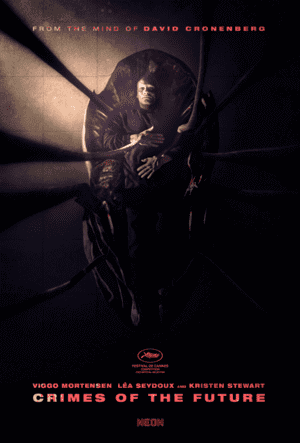The near future. People have a syndrome of accelerated evolution, due to which the body begins to occur amazing changes – people have almost ceased to feel pain. In pursuit of forbidden sensations and forbidden pleasures, a mysterious organization conducts experiments on their own kind. Some accept the new reality, while others try to fight it by any means possible.
4k movies reviews
In David Cronenberg’s first Crimes of the Future movie in eight years, there’s a scene where the characters start picking at the bowels of an ecstatically beating Viggo Mortensen and smiling reverently, “oh yes, it’s beautiful, it’s beautiful. Just so you understand, this is the best illustration of Cronenberg’s directorial method and specifically the style of Crimes of the Future, so if you’re not ready for 110 minutes of such a spectacle, you’d better stay away. All others who stayed, welcome to the most conscious and confessional performance by a living classicist, about the anguish of an artist in a rapidly transforming art world. And a bit of boomer grumbling about how relationships used to be more sensual and sincere, how could they not be.
If you’re going to take this film as a literal horror about some future world that’s been overwhelmed by some epidemic of accelerated evolution, discard that thought immediately. Many have already ruminated on the director’s previous films, trashing, for example, his Cosmopolis as “a movie with an obscure plot where Robert Pattinson just drives around town in a car.” What we have in Crimes of the Future: In some unhealthy, dirty industrial landscape reminiscent of the sets of either The Eraser Head or The Green Elephant, an elderly gray-haired artist who looks like Cronenberg himself and with the same grimace, played by the way by Cronenberg’s favorite actor, performs shocking performances with dismemberment and ahem, drawing on internal organs in front of the audience. It all makes sense now, doesn’t it? All the more reason, naturally, for the artist to come up with more and more elaborate ways to mutilate himself in order to entertain a sophisticated audience. As simple as it is an elegant metaphor about an artist spewing works from his body through pain. In the place of Viggo Mortensen here could be some Clive Barker, John Carpenter, more recently even Alex Garland, but in this particular story David Cronenberg himself is essentially in the lead role. After a long indefinite hiatus from movies, the aging, once eerily relevant author is back with a personal statement, or even, if you will, an excuse for his years of creativity – in essence, “Future Crimes” is the same “The House That Jack Built” by David Cronenberg. Think back to the subtle works the director took a career break after. Pictures about the world of capitalism (Cosmopolis) and Hollywood (The Star Card) audiences refused to accept, without Cronenberg’s famous moves. So here you get a movie about all the same things, only with the obligatory guts and extra limbs, just like you wanted. Old David just laughs at anyone who says, “Well, it’s not the same old Cronenberg body horror, I expected more.” He showed the maximum concentration of everything that audiences have been waiting years for, not accepting his new authorial delights – just like David Lynch rolled out the sequel to Twin Peaks that everyone expected, gloatingly trampling on the nice cherry pies and the good weirdo rednecks.
Cronenberg’s testament wasn’t as enthusiastically received as Trier’s or Lynch’s latest metaphors, but that’s because Cronenberg was never a subtle artist, preferring to dump mountains of severed limbs straight from the screen on the viewer instead of a thoughtful metaphor. Sometimes the metaphors here are so head-on that it becomes embarrassing. The level of subtlety in the imagery: Aronofsky, who has retold a gospel story verbatim in “Mom!” But that’s the fun of the film: when you understand what the director is trying to tell you, you already start trying to guess in what head-on but impressively graphic way he’ll portray another process of creative torment. A typical Charlie Kaufman film (even if it is “Adaptation” or “Synecdoche, New York”) told in the language of David Cronenberg, that’s all. When a filmmaker begins to pontificate about film awards and film festivals, I was just laughing my ass off. Or here’s my favorite scene with the philistine who compares his tumor to the works of Picasso (no different from people who claim they can also draw Malevich’s square). Kristin Stewart is playing Matt Damon here in general, who in real life has been writing to the Dardenne brothers to get him at least a role in their movie, and they’ve ignored him for years because, well, why would the Dardennes want some Matt Damon?
Just one last piece of advice: if the moment one of the characters utters the phrase “Would you look at the raw material?” doesn’t make you laugh out loud, you can turn the movie off – it won’t make you laugh any more. Well, think what you want without context, but my main personal conclusion after the movie: how I wish Kristen Stewart would cut me. Or maybe just maybe I liked this movie so much, because I, like Viggo Mortensen’s character, am not very good at “old” sex either.
Info Blu-ray
Video
Codec: HEVC / H.265 (84.0 Mb/s)
Resolution: Native 4K (2160p)
HDR: Dolby Vision, HDR10
Aspect ratio: 1.85:1
Original aspect ratio: 1.85:1
Audio
English: DTS-HD Master Audio 5.1 (48kHz, 24-bit)
English: Dolby Digital 5.1
French: DTS-HD Master Audio 5.1 (48kHz, 24-bit)
French: DTS-HD Master Audio 2.0 (48kHz, 24-bit)
Subtitles
English SDH, French.

